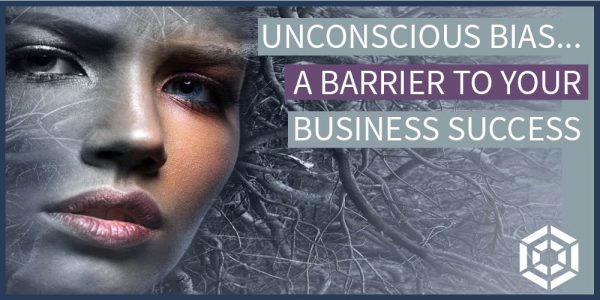The biggest barrier to your success in business is not just that you understand the needs of your customers, but that you understand the unconscious biases driving the buying decisions of those customers. If you would prefer to watch a video of me talking on the subject my Fireside Chat is below.
We’re all guilty of having an unconscious bias towards something or someone. So, what is it? Simply put, Unconscious Bias is a belief or assumption held by an individual or group which affects their attitude or behaviour towards others. Both negative and positive experiences form these beliefs and attitudes.
In order to move these biases from unconscious to conscious, we need to understand how ‘Cognitive dissonance’ drives decision making and influences thinking.
Why Unconscious Bias is the biggest barrier to your business success
We all know that a high percentage of new businesses fail within three years. Estimates vary from 15% in year one to 80% within three years depending on where you look and who you ask. Whatever the true number, we can probably all agree it’s too high. According to an article in Forbes magazine, the number 1 reason was a failure to “really understand their customers via ‘A deep dialogue’
While this may seem obvious, I wonder how many businesses, Entrepreneurs and consultants or coaches fail because they make statistics and data fit in with their assumptions, their unconscious biases, without giving sufficient weight to asking their prospective customers.
When Robert Cialdini first published his seminal work “Influence – science and Practice” back in 1984, he cited key influences that drive people to make a purchase. Thirty-seven years later his work still holds true and is recommended reading for anyone in the business of understanding how social psychology influences purchasing decisions. Cialdini discusses six key influences I.e. reciprocation, commitment and consistency, social proof, liking, authority and scarcity.
Understanding our biases and those of our customers simply provides an addition to the psychology argument. Many of our biases overlap with Cialdini’s key influences.
Examples of unconscious bias
There are dozens of biases, conscious and unconscious. Here are just a few of the most common.
Confirmation Bias – is very common and is simply where we make a piece of information fit with our already formed views. I’m sure we’ve all heard voters before elections state they’ve always voted for X Party and then argue for that party’s policies to confirm their already formed views. You can see that this could be a factor in the example of tourism figures in the earlier example.
Affinity Bias—Preferring people who share the same values as you.
Conformity Bias—Being influenced by the opinions of others with a desire to fit in.
Gender Bias—Preferring one gender over another because of our own gender or beliefs about gender roles and stereotypes.
Halo Effect—Focussing on a positive feature or behaviour, then allowing this positive view to inform unrelated features. When we apply this positively, it can have a beneficial effect and make a big impact.
A good example would be that of Footballer Marcus Rashford who used his status as a gifted, talented footballer to influence government policy on school meals. Cristiano Ronaldo, who is arguably one of the best footballers in the world, is also fanatical about his fitness and diet. He made a point of moving a sponsor’s product away from the camera at a Press Conference during Euro 2020. Millions, if not billions of dollars, were wiped off the share price overnight (the price recovered) of the offending fizzy drink company. Equally, people with a public profile in their positions could have a negative influence if their behaviour and actions were detrimental.
Pain of Payment – a Debit or credit card feels less relational than cash.
Drazen Prelec, associate professor of marketing at the Sloan School of Management, conducted a study with the Massachusetts Institute of Technology and “found that the credit card buyers bid more than twice as much as the cash buyers bid,” at Auctions.
I’m not suggesting a cynical attempt to get people to pay more, but the message is clear. Make it easy for your customers to buy from you on your website or at an event.
Social Proof – There are two types of social proof, positive and negative. The following are examples of two fundraising campaigns:
Positive Proof: “Your £10 will help feed a child in the third world and save his or her life.”
Negative Proof: “Children are literally starving to death in the third world, yet 95% of adults don’t contribute. Don’t be one of the 95%, your £10 could save a child’s life.”
The latter failed as it emphasised the volume of inappropriate behaviour which made it easier to ignore the plea as people felt comfortable as one of the 95%
So, what drives our unconscious biases?
It’s all down to our values and beliefs. Put another way, we are challenged by Cognitive Dissonance.
Cognitive Dissonance.
Cognitive Dissonance occurs when you hold a powerful belief in something, and a new piece of information comes to light which challenges that belief. You then feel so uncomfortable, you reframe the challenging information and make it fit with the existing belief.
It would be truer to call unconscious biases subconscious biases since we form our values from a cocktail of DNA, upbringing and life experience. All filed neatly away in our subconscious.
Coupled with a natural tendency to veer towards the familiar and towards our values and we are then faced with an uncomfortable truth which is we all have minds that possess an element of bigotry. Rather than denying it, we might do better to own it and work on it. This requires an effort on one side and understanding on the other to create a space where we can work on it.
How to deal with our Unconscious Bias
Since there are dozens of stances that are deemed to be unconscious bias, how do we deal with them in our business relationships?
Advertising agencies and marketing departments spend millions of Pounds and dollars on understanding these issues, yet still they sometimes get it wrong. The honest answer is that we really can’t eradicate our unconscious biases, but like our bigotry we can deal with them in three stages.
- First take OWNERSHIP of them.
- We can then raise our AWARENESS of them so that they become conscious.
- Then we can appreciate they are PERCEPTIONS and work on them with someone who can be objective and help us understand why we have them.
OAP for short.
For our customers, we can recognise some key points.
- First, the only way to know what our customers are thinking is to ASK them.
- Then CONVERT the data and test our findings and assumptions with them.
- If we haven’t already, assess the OPTIONS in the marketplace and see how your competitors are communicating their marketing and sales messages.
- We can then RE-EVALUATE and adapt our message
- Lastly, build and NURTURE the customer relationship
ACORN for short.
I’m assuming most of us might think the acronym ACORN to be more positive than OAP. If Social proof is anything to go by, I should be right, but I’m asking and not telling as I don’t you well enough!
ABOUT THE AUTHOR
There are speakers who have led a conventional life, then there are those with a hinterland and Shelley Bridgman is certainly among the latter. Shelley is a Speaker, Performance Coach, Psychotherapist, Hypnotherapist, Trainer, & Author… We are also privileged to have her as a member of Hivemind.
She has been a media commentator specialising in psychotherapy & psychology, with appearances on BBC Television, Sky News, Channel 4 and 5 as well Radio 4’s “Woman Hour” “Midweek” and the “Jeremy Vine Show” on Radio 2. She has also featured in “Psychologies,” and “Therapy Today” magazines.
As a Speaker, Shelley’s topics are Transformational Change, Diversity & Thought leadership. Although speaking has taken over from performing comedy on the Stand-up comedy circuit where she performed five one-woman shows at the Edinburgh Festival and completed a five-night run at The Leicester Square Theatre, performances in Rome and a seven-night run Off-Broadway in New York.




